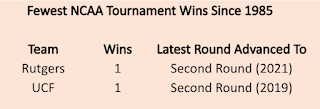Here are the 2023 MAC standings.
So we know what each team achieved, but how did they perform? To answer that, here are the Yards Per Play (YPP), Yards Per Play Allowed (YPA) and Net Yards Per Play (Net) numbers for each MAC team. This includes conference play only, with the championship game not included. The teams are sorted by division by Net YPP with conference rank in parentheses.
College football teams play either eight or nine conference games. Consequently, their record in such a small sample may not be indicative of their quality of play. A few fortuitous bounces here or there can be the difference between another ho-hum campaign or a special season. Randomness and other factors outside of our perception play a role in determining the standings. It would be fantastic if college football teams played 100 or even 1000 games. Then we could have a better idea about which teams were really the best. Alas, players would miss too much class time, their bodies would be battered beyond recognition, and I would never leave the couch. As it is, we have to make do with the handful of games teams do play. In those games, we can learn a lot from a team’s YPP. Since 2005, I have collected YPP data for every conference. I use conference games only because teams play such divergent non-conference schedules and the teams within a conference tend to be of similar quality. By running a regression analysis between a team’s Net YPP (the difference between their Yards Per Play and Yards Per Play Allowed) and their conference winning percentage, we can see if Net YPP is a decent predictor of a team’s record. Spoiler alert. It is. For the statistically inclined, the correlation coefficient between a team’s Net YPP in conference play and their conference record is around .66. Since Net YPP is a solid predictor of a team’s conference record, we can use it to identify which teams had a significant disparity between their conference record as predicted by Net YPP and their actual conference record. I used a difference of .200 between predicted and actual winning percentage as the threshold for ‘significant’. Why .200? It is a little arbitrary, but .200 corresponds to a difference of 1.6 games over an eight game conference schedule and 1.8 games over a nine game one. Over or under-performing by more than a game and a half in a small sample seems significant to me. In the 2023 season, which teams in the MAC met this threshold? Here are MAC teams sorted by performance over what would be expected from their Net YPP numbers.
Miami was the only MAC team that saw their actual record differ significantly from their expected record based on YPP. The Redhawks exceeded their expected record, losing just a solitary conference game. The Redhawks did not pile up conference wins thanks to a great close game record (1-1) or fantastic turnover margin (-1). Instead, they fielded great special teams. They ranked nineteenth nationally in yards per punt and as a team they allowed just north of one yard per punt return (sixth nationally). In addition, their kicker, Graham Nicholson (who is also their punter), did not miss a field goal attempt in conference play (seventeen makes). He did miss a kick in the MAC Championship Game, but the Redhawks picked him up and won anyway.
Losing to FCS Teams
Two MAC school dropped games to FCS teams in 2023. Northern Illinois lost to their in-state brethren (Southern Illinois) and Buffalo lost to another team from the Empire State (Fordham). Akron also needed a miraculous play to avoid losing to Morgan State, but the Zips pulled that one out of the fire. This continued a somewhat disturbing trend for the Bulls and Huskies and for the MAC in general. In the BCS and College Football Playoff Era (since 1998) Buffalo is tied for the most losses among FBS teams to FCS teams. The Bulls have dropped seven games to lower division foes, including two in a row. Northern Illinois is right behind them, having dropped six such games. And of the eleven teams that have lost at least five games to FCS opponents since 1998, five of them either play in the MAC currently or have spent time there in the recent past.
The Bulls are tied with one of the poorest FBS program (Louisiana-Monroe) and a program that is no longer in FBS (Idaho) for the national lead in losses to FCS teams. Perhaps we should remove one of Idaho's losses as they actually pulled an upset as a FCS team this past year. But, you'll notice the Warhawks have not dropped an FCS game in quite sometime while Buffalo is currently riding a two-game skid to FCS teams. Buffalo opens 2024 with a home game against an FCS team (Lafayette), and while they likely upgraded their head coach in the offseason, Pete Lembo has an FCS loss to his credit during his time at Ball State. The Bulls can certainly get back to the postseason in 2024, but to do so, they will need to play better against FCS opponents.






























